|
|
|
Monochord
In ages past the Monochord was constructed by Pythagoras for basic harmonic experiments of tones. In those days it was a simple wooden plate with only one string. With the help of this instrument the mathematical relations of the length of a string to the height of a tone could be measured. The scale of the overtones is based on these proportions.
Today we know the Monochord as an instrument with many strings of the same length, all tuned to the same tone. If you slowly pass your hands alternately over the strings without a break, you get a long-lasting sound that is extraordinarily rich in overtones. The absolutely precise tuning of all strings is essential for the full creation of overtones, otherwise the sound is disharmonious and empty.
Quite often the Monochord is used for meditation music, overtone singing and musical therapy, because the sound is relaxing and balancing for almost everyone; overtones have a healing effect. The Monochord can be played also by children without any practice.

|
KoTaMo
The Kotamo is a combination of three overtone instruments: Japanese Koto, Indian Tambura and modern Monochord. It is a specially developed type of Monochord therapy instrument and it unifies the qualities of all three instruments.
The strings of the Monochord are all tuned to exactly the same note, and the four strings of the Tambura are tuned in fourth, fifth and octave. The Koto has movable frets and allows various scales. Usually it is tuned in pentatonic. Koto and Tambura are both placed on one side of the instrument. When the Kotamo is standing upright it is possible to play on both sides simultanously. One hand passes over the Monochord, the other one improvises on the strings of Koto and Tambura. In the horizontal position both hands play continuously on one side. The Kotamo can also be spun around.
(For more details, see Monochord).

|
Sound Cradle
 
SIKW130 130cm
SIKW150 150cm |
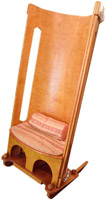 SIKW300
rocking chair |
The Sound Cradle is a modern combination of a musical and a relaxing instrument. Either in lying or sitting position you can enjoy a remarkable sound experience with all your senses. The solid half-round cradle bowl is covered with strings on the sides, there are 2 times 18 strings. It sounds very similar to a Monochord but “stereo”. The Sound Cradle is constructed in a way that it can be used as a cradle, a tunnel, a sound chair or in standing position. Thus it is flexible as almost no other therapy instrument or sound object.
In the cradle bowl you find yourself in a kind of resonating chamber and protection room – here you feel the sounds of the strings very intensely. You hear the sounds as if you were inside a harp, and feel the sounds with your whole body. In direct contact with the instrument you will experience a harmonising sound massage. While simultaneously being cradled you achieve an intense relaxation almost immediately, that has a psychically balancing effect.
The Sound Cradle is tuned like a Monochord – on one side all tones are tuned to A (in the case of the models listed here), on the other side the tones sound a five higher (E´). Additional bass strings on each side offer a more sonorous sound spectrum, rich in overtones. They are mostly tuned in intervals that most people find harmonising and relaxing: fifths and octaves. Of course the strings can be tuned differently too, for example two notes higher or lower. The Sound Cradle keeps its tuning over a long time period when the room is kept at a constant climate. But with the help of a tuning device and the included tuning key it can easily be retuned.

|
Gu Zheng
 SIGZ100 |
The Gu Zheng is a zither which has the shape of a trapezoid with a slightly arched surface. The resonating box is made from wood and has several movable bridges. For tuning, the bridges are moved, which is quite unusal for stringed instruments; they mostly have fixed frets. Traditionally the Gu Zheng had 6 strings, later the number increased to 13. Today the Gu Zheng often has 21 or 25 pentatonically tuned strings which are plucked with plectra attached to the fingers.
Since its beginning in Central China 2500 years ago, a number of different types of Zheng developed, but this instrument is considered the parent instrument, also of many other Zithers in Asia like the Japanese Koto or the Vietnamese Dan Tranh. Its fascinating sound and the variety in its expression have deeply influenced Chinese music.
Incl. Bag, plectra, tuning key, tuning chart.
Stands are sold separately.

|
Autoharp
| 
SIAH100 |
The Autoharp belongs to the Zither family, but has a sophisticated mechanism which makes it an easy string instrument to learn. In the beginning it might seem unusual to play, but soon proves to be simple. One hand operates with the help of a system of buttons and a number of buffers. So when playing a chord all the strings are silenced except those needed for the chord. The other hand passes a plectrum over the strings swiftly and evenly. In that way the desired chord is created and can be changed quickly.
According to the type the Autoharp can have up to 36 strings and a range of 2-4 octaves. Unlike the lying Zither, the Autoharp is played in the upright position or hanging on the body.
Our model here has 21 buttons for major and minor chords.
It is an instrument that can easily be learned by people without musical knowledge and even by disabled persons.
 |
Harp
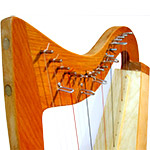
20 Saiten, 83cm high
24 Saiten, 102cm high
27 Saiten, ca. 120cm high |
 |
The Harp is one of the oldest musical instruments known to mankind. For ages the sound of the Harp has been considered to be the magic of divine and supernatural powers. In ancient legends we read how gods and goddesses rule the world with the help of sound: the Finn god Wäinämoinen guides and charms the whole creation, David goes with the Harp to Saul who is tortured by an evil ghost. Still in the 19th century art lovers firmly believed that the sound waves of the Harp conquered evil and saved humanity from worries and anxieties.
This harp comes from a small manufacture in South Germany where each instruments is made by hand. As it is intentionally constructed very simply the price is great. So it is designed for beginners but nevertheless offers a good sound and proper tuning. The harp comes in 3 sizes (see above). Simple half note crooks enable the player to play in 3 tonalities: c-major, f-major and g-major. The strings are from nylon.
Incl. handwritten manual
 |
Lyre
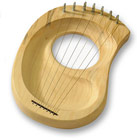
SILE105
7 string
pentatonic, small, round |
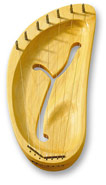
SILE107
7 string
pentatonic,
foot form |
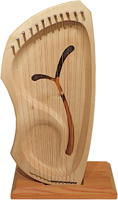 SILE112
12 string
diatonic, ear form |
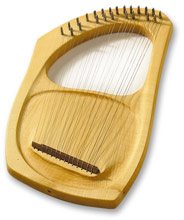 SILE123
23 string
chromatic |

SILE102
Mira |
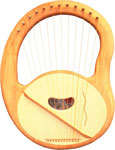
SILE100
Mandala |

SILE101
Munkepunk |
The Lyre is an instrument that resembles a harp, and it is played mostly with one hand. It belongs to the family of stringed instruments where the strings are not plucked like a harp, but the fingers rather pass gently over them.
Some people may know the Lyre only from the antiques like the Greek Kithara or the Celtic Lyra, whose melodies are no longer heard. Only from the old legends we know that its notes had a deeply harmonizing effect on the listeners. In the Greek tales, Orpheus achieved the status of a sound magician, whose tones not only charmed the wild animals in the forest but also the ferocious deities of the underworld.
The historical Lyre once had only 4 strings and was shaped symmetrically. Today the instrument has an asymmetric form, sometimes like an ear, and can have up to 40 strings accommodating different tunings.
We offer models with 7 and 12 strings, with pentatonic and diatonic scales. Instruments with chromatic scale are available on request.
 |
Kantele

SIKT100 Kalevala, 10 string, 50cm, pent./diat.
SIKT200 Silver Moon, 12 string, 55cm, pent./diat. |
In Finnish folklore the old magician-singer Wäinämoinen created the first Kantele from the jaw of a pike. While playing on it all animals of the forest gathered and listened; people left their work and were fascinated by the beauty of the Lute music. Similar stories we know from Orpheus in the Greek legends.
In its classical form the Kantele consists of a wooden resonating body in the shape of a wing. The body is made from a specially crafted Birch trunk. Five strings from horse hair tuned in pentatonic scale cover the body. Modern Kanteles can have up to 36 metal strings and offer a system of hooks which allow the player to change the tone a half-note higher or lower. That can be done even while playing. The instrument is plucked with the fingers while lying on the lap or at a table, similar to a Zither.
 |
Door Harp
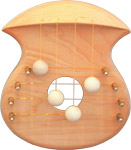
SITH100 Nils |
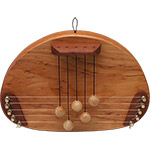
SITH200 dark wood |
The origin of the Door Harp is Finland. Traditionally it hangs at the door to offer the guest a harmonious sound while entering or leaving. Little wooden balls fixed with silk threads dance on the bronze strings of this lovely little instrument.
This Door Harp is made in Germany, hand carved from red Alder. The sound is light and soft.
Other models on request.
 |
Äolsharp
Äolus is the Wind God of Greek mythology. As a living being he loves to move around and play with all that crosses his way. In the 19th Century a kind of wind harp could be found in many parks of Germany, England and Scotland. It was called Äolsharfe — Harp of Äolus. In East Asia too those instruments were known in ancient times.
The Äolsharp you see here is made in Germany and seeks to continue this old tradition. The ever changing mood of the wind elicits ever new melodies of overtones, so the listener will be surprised and charmed in ever new ways. Just put it on the balcony, in the tree in front of your house or at an open window.
The Äolsharp is one meter long and made from weather proof material.
 |
Sitar
 SIST100
|
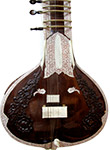 |
The Western Hemisphere came into contact with the Indian Sitar via the Beatles, especially guitarist George Harrison. He later became a student of famous sitarist Ravi Shankar. The Rolling Stones, too, helped the Sitar to become popular, so this classical Indian instrument has a fixed place among the Western stringed instruments.
The Indian Sitar originates from the Veena, which does not enjoy the same popularity as its successor. Those who know Indian classical music know that the Sitar is one of the instruments most played, along with the Tabla, Tambura and Flute. The Sitar is the melody instrument, while Tabla and Tambura serve as indispensable accompanists. In India usually one does not play Sitar alone. This is more popular in the West where the Sitar contributed to the development of new music styles.
The typical outer characteristic of the Sitar is the large round resonating pumpkin body, with the long neck where there are several frets and strings. According to the construction 6 or 7 main strings pass over the curved and movable frets while 11 to 13 resonating strings run underneath. Out of the main strings 3 provide the drones, or accompanying tones, called Chikari. The melody is mostly played on the first string.
The instrument sometimes is supplied with a second resonator, the Tumba, which is placed at the upper end of the neck. Many factors influence the sound quality of the Sitar, for example the form and placing of the bridges. The instrument maker needs a lot of skill and experience in order to construct them properly. It is a fact that for years Ravi Shankar toured the West in the company of his Sitar maker, who alone could guarantee the perfect condition of his instrument.
The way of playing the Sitar is complicated and closely linked with the traditional Indian musical system. Many years of patient practice are needed to achieve mastery of this instrument. But those who listen to its sound are fascinated by its subtle beauty and the richness of rhythms and expression.
 |
Tambura
 SITA100
Classic |
 SITA200
Modern |
 SITA300
Travel |
A typical instrument in Indian classical music is the Tambura or Tanpura. In construction it is similar to the Sitar and thus quite often confused by laymen. The Tambura consists of a large round resonating body made from a pumpkin with a long hollow neck. Beautiful inlaid work and carvings give the instrument a very attractive look.
Traditionally the Tambura has four strings, nowadays up to six. One is tuned to the basic note of the raga, the other to a fourth or a fifth. The last string sounds in the lower octave. So the tuning creates a harmonious chord that serves as an indispensable accompaniment in Indian music, not only for instrumental music but also for singing. Here in the West this traditional accompanying instrument developed into an independent sound body which has great importance for music therapy, overtone singing and world music.
The strings that start at the base of the resonator pass over a broad bridge up to the intricately carved tuning pegs at the end of the neck. Below the bridge there are tuning pearls that resemble the form of almonds. They provide the fine tuning. The typical snaring sound of the Tambura, rich in overtones, is created by threads placed underneath each string. There is one place on the string where it starts snaring and it has to be adjusted each time before playing.
The musician holds the instrument upright while sitting, preferably with crossed legs. The neck is supported by the left hand, the right hand reaches up to the strings, then the outstretched fingers pass gently and continuously over them. It looks easy but it takes some practice in order to produce an even, sonorous sound without interference.
 |
Veena
 SIVA100 |
Saraswati, the Indian Goddess of music and art, is always seen with the ancient Indian string instrument, the Veena, in her hand. Thus it ranks high among the Indian instruments. Though it is not as popular as its successor the Sitar, the Veena is still played today with great respect and love.
There are various types of Veena that differ in construction and sound. The most popular form is the Saraswati Veena, whose photo you can see above. As for the high quality Veenas, the neck and resonating body are carved from one piece of wood, mostly Jackwood. The upper resonator serves rather as a stand for correct positioning than as resonating chamber. Hence it is often made from simple materials like paper mache, but is then decorated nicely. There are 4 main strings that pass over the bridge and several frets, then there are 3 sideways drone strings. The typical position for playing is horizontal, while the instrument rests on the resonators.
The Rudra Veena consists of a tube that rests on two large pumpkins. In the beginning this tube was made from bamboo, today precious wood is used. The ends are carved skillfully as animal heads. It is said that the Veena produces the perfect sound as it suits all kinds of musical expression, which is the proof that it is a truly divine instrument.
 |
Esraj & Dilruba
| 
SIES100
Esraj |

SIDI100
Dilruba |
With a tradition of 200 years the Esraj belongs to the younger generation of Indian stringed instruments, though it is not as famous as the Sitar or Tambura. The Esraj is mostly played in Bengal, Bangladesh and central India. In the north it is known as the Dilruba, whose construction is also slightly different. The Dilruba is bigger and has a larger sound box, therefore the sound is louder and more sonorous. The Esraj charms the listener with the gentle delicate sounds that gave it the name “robber of the heart”.
Both instruments are rich in overtones as they have many sympathetic strings, a typical sign for Indian instruments.
The Esraj and Dilruba have four main strings but the melody is played with a bow only on the first, and the others just resonate. The heavy curved metal frets are fixed with a cord and can be moved for tuning.
Usually the musician sits with crossed legs on the ground and holds the instrument in front of himself. The neck leans against the shoulder.
Traditionally the Esraj is played as an accompanying instrument but its meditative vastness makes it perfect for playing melodies. In the West it became famous by the Indian musician Sri Chinmoy, who played it on all of his numerous concerts. Under his influence the Esraj developed further so that its sound has reached a fascinating expressiveness, stronger than traditional instruments offer.
Both instruments are sold with an Indian style bow but can be played with a common violin bow, which is easier to handle for most Western players.
Cases are sold separately.

|
Erhu
| 
SIER100 |
The Erhu is known as the “Chinese violin”, and is therefore found in almost every Chinese orchestra, but also played in small ensembles or as a solo instrument. The construction is lightweight and delicate as one would expect from an Asian instrument, nevertheless the Erhu excels through its richness of expression. The sound is like melancholy crying that touches the listener deeply.
The small resonating chamber is hexagonal and covered with skin. The neck is merely a thin stick with two tuning pegs. The Erhu has only two strings and the hair of the light bow is placed in between them. Thus the strings are played with each movement of the bow. The instrument is played sitting down, placed on the top of the left thigh.
The strings are usually tuned to a fifth: to D and A. The notes are produced with an underhand grip. The hair of the bow is slightly loose and the fingers of the other hand tighten it while playing.
Case included.

|
Psaltery

SISP100 |
The Bowed Psaltery originates from the Orient. The wooden body has the form of a long stretched triangle. The pegs are fixed at the edge on both sides. The strings are played between the pegs with a bow.
The chromatic type has 20 strings with a scale from C´ to G´´. On the right side there are the notes of C major, on the left side the complementary half-notes. The pentatonic Psaltery is specially built as it has double strings for each tone, except for the lowest. One advantage is that it can be played with two bows. The other, that the sound quality of the instrument is improved to a great extent. When one string is played, another equally tuned string sounds simultaneously. Due to its inner harmony this Psaltery is perfect for improvisation as each tone fits with the other and there is no disharmony.

|
Singing Saw

SISG100 |
We offer the “Original Feldmann Singing Saw”, made in Germany which looks back on a long tradition. This is how it came into existence:
At the beginning of the 20th century, a blacksmith did not have any way to test the right degree of steel's hardness when it had been in the fire. What he did was to strike the steel with a hammer. When it produced a special long lasting tone the hardness was fine. Carl Feldmann was a creative cutler in Remscheid, Germany, who wanted to experiment with different types of steel. In night-long tests he discovered the best possible metal and had the idea to pass a bow over the back of the metal saw. Later on he determined the ideal conical form to create several scales. The result of his experiments was the Singing Saw, named after him as we know it today.

|
Guitar
| 
SIGT100 | 
|
Guitar-like instruments have been in use for 5000 years. The name Guitar originates from the Spanish language (Guitarra) and was then transferred to German. It reaches back to the old Greek word Kithara which describes a Lute instrument of Greek Antiquity.
But no matter where the Guitar actually comes from, everybody knows it. It is one of the best-known string instruments. Certainly one reason for its popularity is the great variety of ways to express rhythms, melodies and moods. The best proof is in the manifold genres where the Guitar is played.
 |
Guitarbanjo
| 
SIGB100
|
The Guitarbanjo comes from Africa, and became a very popular string instrument in America. It is easy to play and suitable for many music styles. Therefore various sizes and types developed like the Guitarbanjo, the five-stringed Banjo, Ukulelebanjo, Mandolinbanjo and others. The Guitarbanjo has six strings and a large sound box made from metal. Guitarists can play it without difficulties.
 |
Bouzouki

SIBZ100
Irish Style |

SIBZ200
Sakis Greek |
The Bouzouki is one of the most important string instruments of Greek music. Our original Greek model from the Sakis workshop is tuned to Gg-dd´-aa-d´d´´.
The other type is built like the Irish Mandolin and has a flat body. It is perfect for every kind of folk music. Tuning and mensur correspond to the Greek example.
 |
Charango

SICH100 |
The Charango belongs to the family of plucked instruments. It was developed in the 16th Century from the Chitarra battente of the Spanish and Portuguese conquerors.
Originally the dried shell of an armadillo was used as the resonating body; nowadays it is replaced by a wooden body. Of course this was due to the protection of animals. The construction of a Charango is quite similar to the Guitar but it is much smaller.
The left hand makes the chords while the right hand plucks the five double strings (Nylon) of different thicknesses. They are not tuned in the normal rising height but crosswise. Therefore it is a bit difficult for Guitar players to get used to the Charango.
The rhythmic striking technique is quite common when all the strings are played together as a chord. Either the Charango is held on the right of the chest or upright on the right thigh.
 |
Ukelele
Portuguese immigrants originally brought the Ukulele to Hawaii. There it received its name which means “hopping flea”. Probably the Hawaiian people got this impression while seeing the fingers moving fast over the strings.
The Ukulele is a small Guitar-like plucked instrument that is usually covered with 4-8 strings. Its normal size is 60cm long and 20cm wide, and is thus considered by most people as a toy Guitar for children. From Hawaii the Ukulele spread to North America and returned from there to the “Old World”. In the German countries it became famous recently in the Stefan Raab TV show.

|
Mandolin

SIMA100
Italian flat body |

SIMA200
|
Mandolins belong to the family of Guitar-like plucked instruments. Either they have a round body, as is traditional in Southern countries, or a flat one. The latter is quite common in Irish music. We offer both types: there are simple low budget instruments or models of high quality from various brands.

|
Mandola

SIMA300 |
As the name suggests, the Mandola is related to the Mandolin, like the Viola to the Violin. The relations in size and tuning definitely are the same as in the violin family. The Mandola originates from the Lute and has seen several changes of name and construction. Nowadays the Mandola is not as popular as the Mandolin; it is mainly played in folk music like Irish folk. It is tuned a fifth lower than the Mandolin, usually in C-G-D-A. Like the guitar the Mandola can be acoustic or electric.
 |
Shamisen
 SISH100 |
The Shamisen is one of the most popular and widely played instruments of Japan. As is the case with several other instruments, this lute originates from Chinese string instruments, and came to Japan only at the end of the 16th century. There it developed its form as we know it today. The Shamisen consists of a rectangle or oval wooden body with a long slim neck. The rather small resonating box is mostly covered with skin from cats or dogs which gives it a brilliant sound. The width of the neck influences the sound, too. Therefore three different sizes exist.
The three stringed lute is held like a guitar and plucked with a plectrum. To play the Shamisen was part of the education of a Geisha, the Japanese entertainer-artist. It is a perfect solo instrument but also suits ensemble and chamber music. The Shamisen has an established place in Japanese stage music.
 |
Morin Khuur
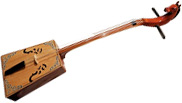 SIMK100 |
The Morin Khuur, also known by the name “Horse-head Fiddle”, is the most important musical instrument of Mongolia and considered a symbol of the nation. Its sound is described as expansive like the wind in the grasslands. It also imitates the neighing of the horses that are typical of this country. Therefore the scroll is always carved in the form of a horse’s head. The wooden sound box has the form of a trapezoid and is decorated with intricate patterns. The long narrow neck has only two strings, similar to the Erhu. It is an interesting fact that one string is “male” with 130 hairs from a stallions´s tail and the other one is “female” with 105 hairs from a mare´s tail. Traditionally the strings are tuned a fifth apart but nowadays a fourth is quite common.
The musician places the Morin Khuur upright on his lap or between the legs. The bow is strung loosely with horse’s hair, the fingers of the right hand tighten it while playing. In that way he can create subtle sound nuances. The fingers of the other hand play the main string without using frets. The modern type of Horse-head Fiddle is made with synthetic hair and is also used by Mongolian musicians.
There are some legends that tell the birth of the Morin Khuur. One says that a shepherd received a magical winged horse as a gift. On his back he would fly to meet his beloved. Out of jealousy another woman had the wings of the horse cut off so it fell from the air and died. The grieving shepherd carved a fiddle with a horse head from the bones of the animal. He covered it with its skin and used the horse’s hair for the strings and the bow.
 |
Pipa
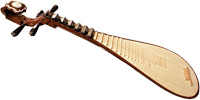 SIPI100 |
The Chinese Pipa belongs to the short neck lutes. Since it came out in the Han Dynasty it has became a popular solo and concert instrument. A remarkable attribute of the Pipa is its drop-like shape. It is not a huge instrument but of harmonious proportion and handy size. On the front, numerous wooden frets in the form of trapezoids with four strings are fixed. Usually the strings are tuned to a-d-e-a. The Pipa produces a pure and brilliant sound.
 |
Pitch Pipes

Pitch Pipes
ZUSG002
|

Chromatic Tuner
ZUSG001
|
 |
Tuning Keys

ZUSS001
for Auris-Leier, Harp, KoTaMo chinese style
|

ZUSS002
for Kantele, Äolis-Leier, KoTaMo japanese style
|
 |
Kolofonium
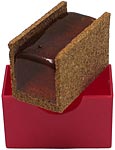
Kolofonium
ZUKF001
|

Pirastro Kolofonium
ZUKF002
|
Just for those who do not know, the hair of a string bow is rubbed with Kolofonium (a resin) so as to create the proper friction while playing. This simple Kolofonium is suitable for all our string instruments. Special types are available on request.
Pirastro Kolofonium is specially designed for violin strings. It has the best adhesive power and has a soft consistency.
 |
|
Copyright © Gandharva Loka |

